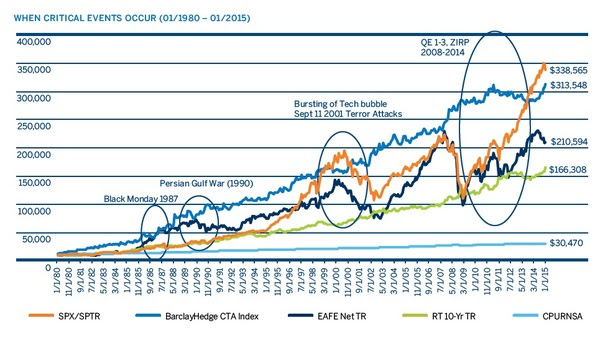
Managed futures, as represented by the BarclayHedge CTA Index, have gone through a tough period. So tough, in fact that some pundits have labeled the asset class, which is made up primarily of trend-following approaches, as “dead”, or no longer viable in this economy.
I have a few observations. In the 37 years from 1980 through 2017, the total return generated by the S&P 500 Index has only exceeded the total return of the BarclayHedge CTA Index on two occasions, once in 2000 for a few months, just prior to the crash and again, right now. (Source: CME Group, 10 Reasons to Trade Managed Futures, 2016)
One of the deciding factors in adding managed futures to an investment portfolio is not only its diversification but also its uniquely strong negative correlation to stocks in a market crisis. Keep in mind, the BarclayHedge CTA Index was profitable in 1980, 1987, 1990, 2000, 2001, 2002 and 2008. These are all years in which the stock market suffered a substantial drawdown. (Source: Managed Futures Today, May 2010, “Thirty Years of Managed Futures”)
Managed futures do not have the same drivers as the stock market. There is a is a zero to slightly negative correlation to the stock market in general. In other words, when the stock market goes up we would not necessarily expect the managed futures index to go up. We should celebrate this difference, not malign it. In today’s world every other asset class has a record high correlation of over 87% to the stock market. Think real estate, private equity, hedge funds and fixed income. It would seem to me that the addition or increase in allocation of managed futures to the standard stock and bond portfolio would be not only prudent but critical from a risk allocation stand point. (Source: RCM, “Managed Futures Correlation” Oct. 2017)
Trend-following composes more than 75% of managed futures. Trend-following is a long volatility investment. Stocks on the other hand generally suffer in an increase in volatility. So much so that the VIX is often called the “Fear Index” because when it rises sharply it is usually associated with a collapsing stock index. 2017 has been a unique year. The VIX has set a new all-time low and has hovered there all year. The S&P has not had a break of over -2.3% on a weekly basis the whole year. So, with that in mind, you would not expect a strong trend-following market and you haven’t had one. (Source: BarclayHedge Dec 2017)
If we look at the performance of the managed futures index from 1980 until the present it is very enlightening. From 1980 until 2009 the managed futures index only had three losing years and those years the loss was very small, around 1%. Since 2009 managed futures has only had two winning years. What happened? The great recession happened. (Source: BarclayHedge Dec 2017) This led to a “regime” that engineered an increase in sovereign debt by a staggering $10 trillion, near zero real interest rates for eight years and easy money lending standards. The byproduct of that was -$3.5 Trillion on the FED balance sheet. Corporate profits stagnated but stock valuations soared on M&A and stock buy-backs. How do you accomplish that? Easy if you are the FED, you just print money. The Fed has been so important to the rise in the stock market that when the news was good it pressured stock prices and when it was bad the market went up. Investors knew that the Yellen Fed would not raise rates if there was any excuse not to do so.
Most investors would agree, we have had a regime change. Since Trump was elected in November of 2016, Fed Chief Janet Yellen seems to have seen the light and the Fed is now moving to “normalize” rates. The “great experiment” is winding down and the Fed has announced that it will now be raising rates by small increments into the foreseeable future. Additionally, she has stated that the Fed will not reinvest bonds as they expire, thus draining the economy of the $3.5 trillion in liquidity. (Source: Janet Yellen, FOMC Press Conference Oct and Dec 2017) If one accepts that much of the historic rise in the stock market was the direct result of Fed policy then, raising rates and draining $3.5 trillion from the economy at the same time may create more than “head winds” for an economy that is just now beginning to get its legs under it.
As I have discussed here many times, I believe market timing is a losing strategy. I recommend that you stay invested in the stock market but make sure that you have a 10%-20% allocation to managed futures. It could make a huge difference when you need it most.
Best Regards,
Tom Reavis
President
Worldwide Capital Strategies, LLC
The content of this article is based upon the research and opinions of Tom Reavis.
